User Area
Software Release History - Version 21
Version
21.1 | Version
21.0
New Facilities and Improvements
in LUSAS Version 21.1
V21.1-2 was made available for download on 6
December 2024
This is an error
fix release.
V21.1-1 was made available for download on 30
October 2024
This is an error
fix release.
V21.1-0 was made available for download on 22 July 2024
This is a minor
update release of new facilitites, enhancements and change requests.
In summary...
This release provides the following:
LUSAS
Tank
- In
view of its application to more than just LNG storage tanks,
the LNG Tank System has been renamed and is now available as
a LUSAS software product called 'LUSAS
Tank'. It is available either as a single licensed product
allowing the generation of concrete, metallic, and steel roof-only
models, or it can be individually licensed for each of those model
types.
- Vertical
prestress with tapered walls is now fully
supported for 3D shell models. A dummy vertical prestress tendon
arrangement is used initially. Tendon details are subsequently
updated with user-defined data.
- Steel
roof-only models may now be created. Library
sections and steel frame design attributes are also added for
roofs in metallic tanks. An orthogonal arrangement of beams is now
supported for the central region of a steel roof.
- Setting
up Eigenvalue
buckling and GNL
buckling analyses is now automated for 3D shell
and other models.
- LUSAS
Tank help information is now available from
within Modeller help.
|
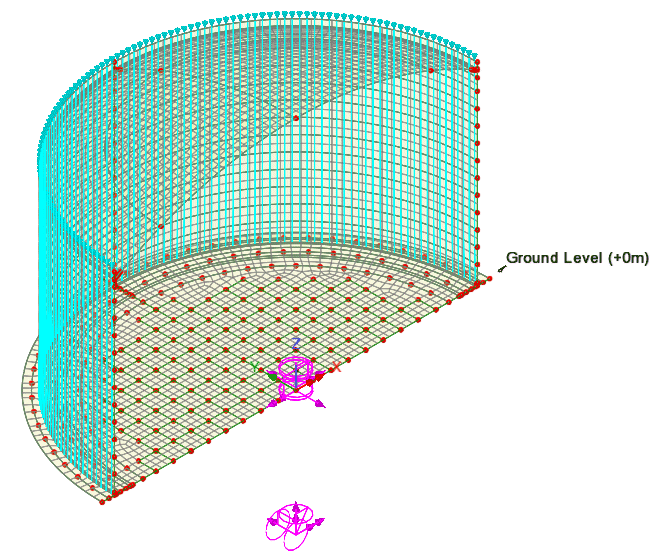
|
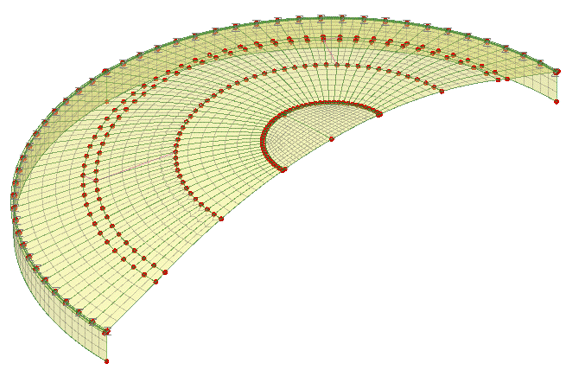
|
|
Vertical
prestress loading visualised on a 3D shell half-model
|
Steel
roof-only half-model
|
Primary
and secondary prestress results now available for beam models
- The Prestress
loading and results facility has been
improved. For beam models it is now possible to calculate and
view, for each stage of a construction process in a nonlinear /
time domain analysis, primary and secondary load effects arising
from prestressing, and primary effects from each tendon loss type
(friction, anchorage, elastic shortening, creep, shrinkage and
relaxation).
- Now,
after a tendon loading assignment is made, a 'Prestress analysis
options' cog is added to the Analyses
 Treeview
within the corresponding analysis. Editing of this entry displays
a Prestress
Analysis Options dialog that allows
specifying whether to calculate the primary and secondary effects,
results excluding prestress effects, and/or primary effects
associated with tendon losses. After solving, the Analyses Treeview
within the corresponding analysis. Editing of this entry displays
a Prestress
Analysis Options dialog that allows
specifying whether to calculate the primary and secondary effects,
results excluding prestress effects, and/or primary effects
associated with tendon losses. After solving, the Analyses  Treeview
is populated with results loadcases according to the selections
made. The results obtained may be used in combinations and
envelopes. Treeview
is populated with results loadcases according to the selections
made. The results obtained may be used in combinations and
envelopes.
Masonry
Bridge Wizard
- The Masonry
Bridge Wizard has been rationalised and
enhanced with new menu items and tabs for the definition of Bridge
data, Spans, Internal spandrels, Modelling and Loading, and the
creation of models.
Steel
frame design
- The Steel
frame design software option now supports United
States of America AASHTO
9th Edition, and includes
checks for double angles.
RC Slab
/ Wall design
Vehicle
load optimisation
Enhancements to the Vehicle
Load Optimisation softwarre option include:
- Support for United
Kingdom assessment code CS
458 rev0 with ALL Model 2
- Support for centrifugal
loading to AASHTO
LRFD Bridge Design Specifications 7th Edition
- Improved viewing
of loading patterns at a selected node or slice for VLO envelope
runs.
Response
Spectra
- The
United States of America ASCE
7-16 response spectrum and the ASCE
7-22 two-period design response spectrum
have been added to the response spectra library.
- The
Indian IRC:6-2017 and IRC:SP:114-2018 response
spectra have been added to the response spectra library.
- The
selection of a code-based response
spectrum (for IMD use) is simplified by the
addition of a 'Country' drop-list, which displays only the design
codes for that country.
Temperature
profile loading
- United
Kingdom assessment code CS454
v1.1.0 is now supported.
Creep
and Shrinkage modelling
- Creep
and Shrinkage to AS5100.5-2017 (Australia)
is now supported.
Rail
track analysis
The Rail
Track Analysis software option now also supports
spreadsheet data in convenient US units in addition to the supported
metric units. When the model is built from the data in the
spreadsheet, all input is converted to consistent SI units of
N,m,kg,s,C, or to consistent US units of kip,ft,kslug,s,F as specified
by the user.
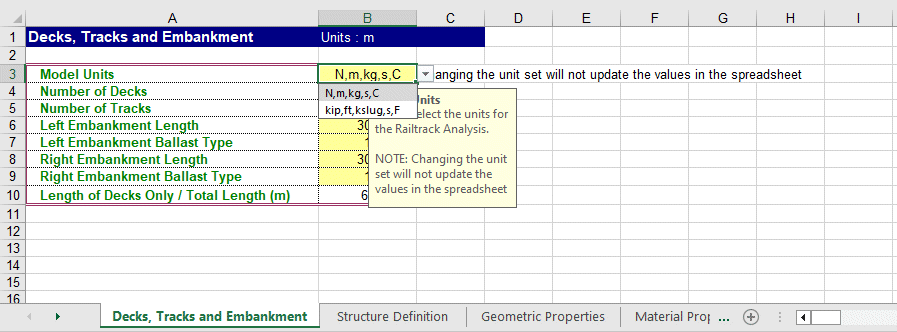
Model
previews now provided
-
Saving
a model in Version 21.1 now also saves a preview image of the
model to the model file. This is taken from the active view window
at the time of saving and excludes any axis cube, coordinate
system, border or annotation present. When the File > Open
dialog is used to open a model saved in this version, the preview
image is displayed for each file selected. Model files saved in
previous versions will not show a preview until opened and saved
in this version.

Improved
visualisation
-
Anti-aliasing
is now provided, giving smoother visual displays. This is set 'on'
by default within the Graphics tab
of the LUSAS Configuration Utility, and is applied by default for
new model view windows. Legacy models and new models will adopt
the setting made here, unless changed on the Screen tab
of the View Properties dialog.
|
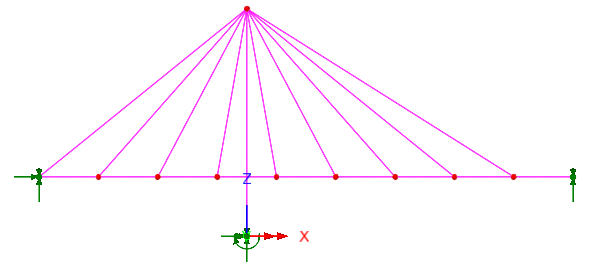
|
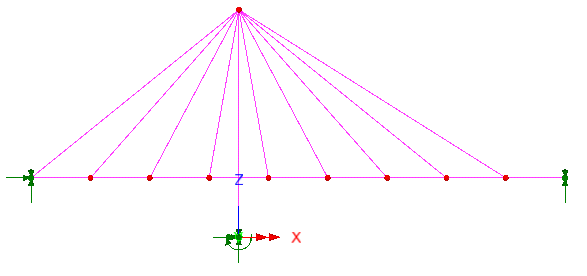
|
| Anti-aliasing
'on' |
Anti-aliasing
'off' |
Graph
through 2D
- When
the visibility of a graph's location is changed (because the whole
model has been made visible or invisible), the associated graph's
"visualise" state is changed to match
- Changing
the visibility of a graph also changes the visibility of the
associated graph location. A graph that is "not
visualised" will show no diagram.
- An
automatic description is now appended to each graph dataset's name
in the treeview, for example "Graph 1 (Time history)" or
"Graph 2 (Graph through 2d)" or "Graph 3
(Slidelines)"
Other
enhancements
- Expressions entered
in edit boxes are now retained. Previously only the evaluated
values were stored.
- Print
results wizard can now show displacements
and reactions for inactive nodes.
- Nonlinear
control settings have been updated with the
default value for 'Displacement norm' changing from 1.0 to 0.1,
and the default value for 'Incremental displacement norm' changing
from 1.0 to 0. This offers the user a reliable first run that
should converge fairly quickly and be problem free for a good,
stable model. The location of the two inputs has been swapped,
with 'Displacement norm' now specified on the Solution
strategy panel of the main nonlinear control
dialog, and the Incremental displacement norm' now specified on
the advanced
solution strategy dialog.
- Solve now dialog The
'Solve now' dialog has been simplified. The checkbox providing the
ability to 'Compute prestress losses' independently from an
analysis has been removed. Changing
any of the 'Solver options' on the dialog no longer marks all
analyses as "needing to be solved".
Retired
and replacement elements
-
The
2D isoflex thick plate flexure element (QSC4) has been retired and
replaced with new 2D isoflex thick plate flexure elements
(TTF3/QTF4). The new element family offers both triangular and
quadratic elements, allowing the combination of available elements
to be used to create an irregular or transition mesh where needed.
Documentation
User
manuals
Relevant
documentation has been updated for this new release.
Selected
manuals are provided in PDF format as part of the LUSAS installation
and are also available for download from the LUSAS website.
Worked
Examples
Worked
examples (in PDF format) and associated files referenced by those
examples are available for download from the User Area of the LUSAS
website.
|